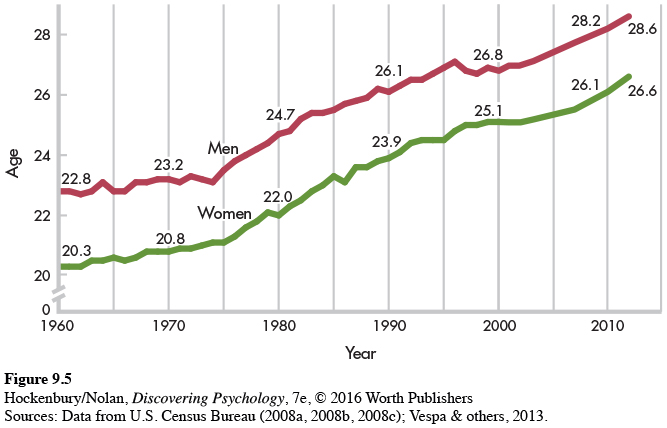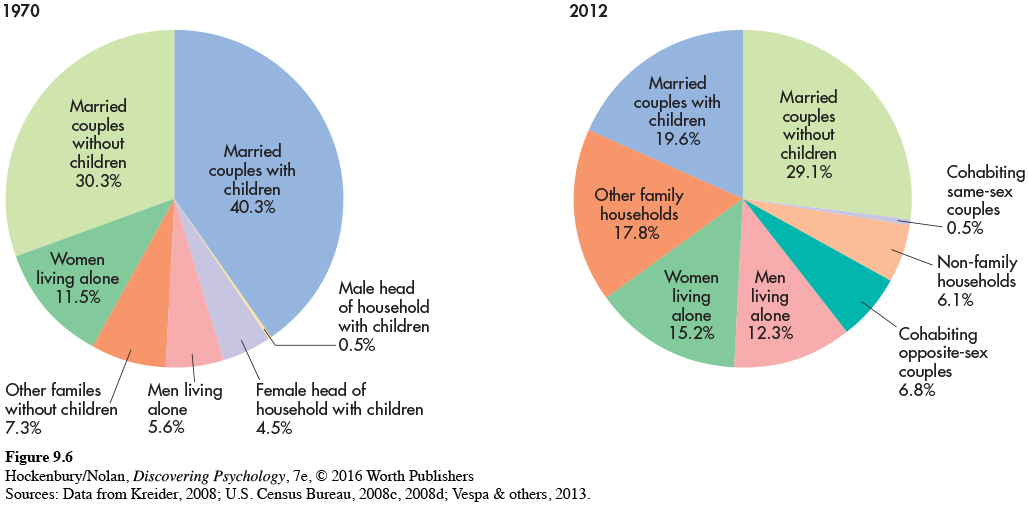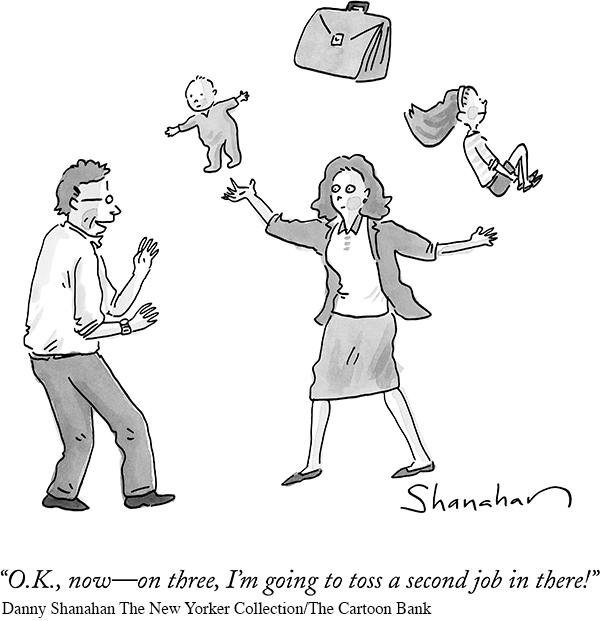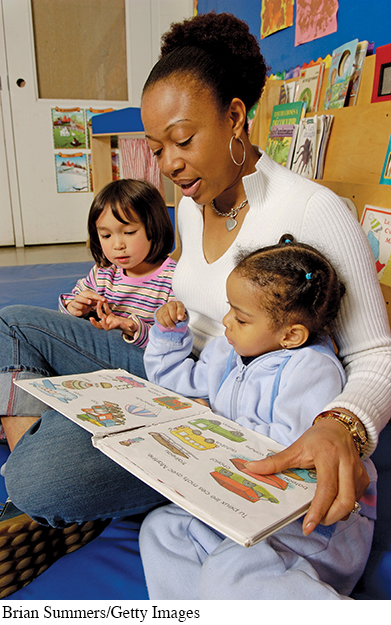Adult Development
KEY THEME
Development throughout adulthood is marked by exploration, physical changes, and the adoption of new social roles.
KEY QUESTIONS

What is emerging adulthood?
What physical changes take place in adulthood?
What are some general patterns of adult social development?
You can think of the developmental changes you experienced during infancy, childhood, and adolescence as early chapters in your life story. Those early life chapters helped set the tone for the primary focus of your life story—
In his theory of psychosocial development, Erik Erikson (1982) described the two fundamental themes that dominate adulthood: love and work. According to Erikson (1964b, 1968), the primary psychosocial task of early adulthood is to form a committed, mutually enhancing, intimate relationship with another person. During middle adulthood, the primary psychosocial task is generativity—to contribute to future generations through your children, your career, and other meaningful activities. In this section, we’ll consider both themes as we continue our journey through the lifespan.
Emerging Adulthood
At one time, adolescence marked the end of childhood and the beginning of adulthood. Even as recently as the mid-
According to Erikson’s (1964) theory, the identity conflict should be fully resolved by the end of adolescence. However, Arnett (2010) contends that in today’s industrialized cultures, identity is not fully resolved until the mid-
Many emerging adults feel “in between”: they are no longer adolescents, but not quite adults. Although some find this instability unsettling and disorienting, several studies have found that well-
While some emerging adults establish long-


IN FOCUS
Hooking Up on Campus
Pop culture and the news media alike have been abuzz about today’s hook-
Although there’s nothing new about casual sex among young adults, hooking up does differ in some key ways from casual sex. Casual sex refers, by definition, to sexual intercourse, with or without an emotional or friendly relationship. In a “friends with benefits” relationship, the sexual relationship is presumed to be secondary to the friendship. In contrast, “hooking up” refers to a no-
On many college campuses, hooking up is very common. Studies have shown that about 80 percent of students reported hooking up at least once while they were in college, and more than half had hooked up during the previous year (Owen & others, 2010; Reiber & Garcia, 2010). In one study, about 60 percent of students reported that their most recent hook-

Male college students have more favorable attitudes toward hooking up than female college students, although the sexes may not be as far apart as some people think (Bradshaw & others, 2010). As compared to men, women tend to report more negative emotional reactions after hooking up than men (Lewis & others, 2012). However, both men and women reported that hooking up had overall been a more positive than negative experience (Lewis & others, 2012; Owen & Fincham, 2010).
Although hooking up is widely accepted on college campuses, both sexes overestimate the degree to which the opposite sex is comfortable with hooking up (Reiber & Garcia, 2010). Today’s young adults haven’t given up on the hope of creating a long-
Emerging adults also actively explore different career options (Hamilton & Hamilton, 2006). On average, emerging adults hold down an average of seven different jobs during their 20s (Arnett, 2004).
Emerging adulthood is a time of life when many different directions remain possible, when little about the future has been decided for certain, [and] when the scope of independent exploration of life’s possibilities is greater for most people than it will ever be at any other period of the life course.
—Jeffrey Jensen Arnett (2000)
Is emerging adulthood a universal period of development? The answer appears to be no. According to Arnett (2011), emerging adulthood exists only in cultures in which adult responsibilities and roles are postponed until the 20s. This pattern occurs most typically in industrialized or post-
Physical Changes in Adulthood
Your unique genetic heritage greatly influences the unfolding of certain physical changes during adulthood, such as when your hair begins to thin and turn gray. Such genetically influenced changes can vary significantly from one person to another.
However, genetic heritage is not destiny. The lifestyle choices that people make in young and middle adulthood influence the aging process. Staying physically and mentally active, avoiding tobacco products and other harmful substances, and eating a healthy diet can both slow and minimize the physical declines that are typically associated with aging.
Another potent environmental force is simply the passage of time. Decades of use and environmental exposure take a toll on the body. Wrinkles begin to appear as we approach the age of 40, largely because of a loss of skin elasticity combined with years of making the same facial expressions. With each decade after age 20, the efficiency of various body organs declines. For example, lung capacity decreases, as does the amount of blood pumped by the heart, though these changes are usually not noticeable until late adulthood.
Physical strength typically peaks in early adulthood, the 20s and 30s. By middle adulthood, roughly from the 40s to the mid-
Significant reproductive and hormonal changes also occur during adulthood. In women, menopause, the cessation of menstruation, signals the end of reproductive capacity and occurs anytime from the late 30s to the early 50s. For some women, menopause involves unpleasant symptoms, such as hot flashes, which are rapid and extreme increases in body temperature (Umland, 2008). Other symptoms may include night sweats and disturbances in sex drive, sleep, eating, weight, and motivation. Emotional symptoms may include depression, sadness, and emotional instability (E. Freeman, 2010).
Cultural stereotypes reinforce the notion that menopause is mostly a negative experience (APA, 2007). However, many women experience “postmenopausal zest.” Freed of menstruation, childbearing, and worries about becoming pregnant, many women feel a renewed sense of energy, freedom, and happiness. Postmenopausal women often develop a new sense of identity, become more assertive, and pursue new aspirations (Fahs, 2007). In many cultures, postmenopausal women are valued for their experience and wisdom (Robinson, 2002).
Middle-
MYTH SCIENCE
Is it true that many middle-
Does the loss of reproductive capability trigger a “midlife crisis” in women, or especially, in men? No. Consistently, psychological research has shown that there is no such thing as a midlife crisis (see Clay, 2003; Sneed & others, 2012). Instead, most men and women who experienced a “crisis” of depression or despair during middle age also experienced depression, anxiety, and similar crises in young adulthood (Wethington, 2000).
Social Development in Adulthood
The “traditional” track of achieving intimacy in adulthood was once to find a mate, get married, and start and raise a family. Today, however, the structure of American families varies widely (see Figure 9.6). For example, the number of unmarried couples living together has increased dramatically—

Given that more than half of all first marriages end in divorce, the phenomenon of remarrying and starting a second family later in life is not unusual. As divorce has become more common, the number of single parents and stepfamilies has also risen. And among married couples, some opt for a child-
Such diversity in adult relationships reflects the fact that adult social development does not always follow a predictable pattern. As you travel through adulthood, your life story may include many unanticipated twists in the plot and changes in the cast of characters. Just as the “traditional” family structure has its joys and heartaches, so do other configurations of intimate and family relationships. In the final analysis, any relationship that promotes the overall sense of happiness and well-

THE TRANSITION TO PARENTHOOD
KIDS ‘R’ US?
Although it is commonly believed that children strengthen the marital bond, marital satisfaction and time together tend to decline after the birth of the first child (Doss & others, 2009; Lawrence & others, 2010). For all the joy that can be derived from watching a child grow and experience the world, the first child’s arrival creates a whole new set of responsibilities, pushes, and pulls on the marital relationship.
Without question, parenthood fundamentally alters your identity as an adult. With the birth or adoption of your first child, you take on a commitment to nurture the physical, emotional, social, and intellectual well-
Parenthood is further complicated by the fact that children are not born speaking fluently, so you can’t immediately enlighten them about the constraints of adult schedules, deadlines, finances, and physical energy. Instead, you must continually strive to adapt lovingly and patiently to your child’s needs while managing all the other priorities in your life.
Not all couples experience a decline in marital satisfaction after the birth of a child. The hassles and headaches of child rearing can be minimized if the marital relationship is warm and positive, and if both husband and wife share household and child-

That many couples are marrying at a later age and waiting until their 30s to start a family also seems to be advantageous. Becoming a parent at an older age and waiting longer after marriage to start a family may ease the adjustment to parenthood. Why? Largely because the couple is more mature, the marital relationship is typically more stable, and finances are more secure (Hatton & others, 2010; Nelson & others, 2014).
In developed societies, dual-
Many working parents are concerned about the effects of nonparental care on their children. Earlier in the chapter, we discussed the importance of attachment relationships between young children and their primary caregivers. In the Critical Thinking box on the next page, we take a close look at what psychologists have learned about the effects of day care on attachment and other aspects of development.

CRITICAL THINKING
The Effects of Child Care on Attachment and Development
The majority of children under the age of 5 in the United States—
Developmental psychologist Jay Belsky (1992, 2001, 2002) sparked considerable controversy when he first published studies showing that infants under a year old were more likely to demonstrate insecure attachment if they experienced over 30 hours of day care per week. Based on his research, Belsky contended that children who entered full-
However, reviewing the data in Belsky’s and other early studies, psychologist Alison Clarke-
In other words, most of the children who had started day care in infancy were securely attached, just like most of the children who had not experienced extensive day care during infancy (Phillips & Lowenstein, 2011). Similarly, a large, long-
Researchers agree that the quality of child care is a key factor in facilitating secure attachment in early childhood and preventing problems in later childhood (NICHD, 2003a, 2003b; Vandell & others, 2010). Many studies have found that children who experience high-
Child care is just one aspect of a child’s developmental environment. Sensitive parenting and the quality of caregiving in the child’s home have been found to have an even greater influence on social, emotional, and cognitive development than the quality of child care (Belsky & others, 2007).
Clearly, then, day care in and of itself does not necessarily lead to undesirable outcomes (Belsky, 2009). The critical factor is the quality of care (Phillips & Lowenstein, 2011). High-

Characteristics of High-
The setting meets state and local standards, and is accredited by a professional organization, such as the National Association for the Education of Young Children.
Warm, responsive caregivers encourage children’s play and learning.
Groups of children and adults are consistent over time, helping foster stable, positive relationships. Low staff turnover is essential.
Groups are small enough to provide the individual attention that very young children need.
A minimum of two adults care for no more than 8 infants, 12 toddlers, or 20 four-
and five- year- olds. Caregivers are trained in principles of child development and learning.
Developmentally appropriate learning materials and toys are available that offer interesting, safe, and achievable activities.
SOURCES: National Institute of Child Health and Human Development, 2006; National Association for the Education of Young Children, 2009; National Association of Child Care Resource & Referral Agencies (NACCRRA), 2010.
CRITICAL THINKING QUESTIONS
Why is it difficult to definitively measure the effects of day care on children?
Given the benefits of high-
quality child care, should the availability of affordable, high- quality care be a national priority?
Do adults, particularly women, experience greater stress because of the conflicting demands of career, marriage, and family? Not necessarily. Generally, multiple roles seem to provide both men and women with a greater potential for increased feelings of self-
Although marital satisfaction declines when people first become parents, it rises again after children leave home (Gorchoff & others, 2008). Thus, most parents do not experience feelings of sadness, emptiness, and loss when their last child leaves home, often called the “empty nest syndrome” (Bouchard, 2014). Successfully launching your children into the adult world represents the attainment of the ultimate parental goal. There is also more time to spend in leisure activities with your spouse. Not surprisingly, then, marital satisfaction tends to increase steadily once children are out of the nest and flying on their own. Relatively recent is the new phenomenon of boomerang kids—adult children returning home after a brief period on their own because of economic pressures. Just as children’s departure positively affects marital satisfaction, the return of those same children can have a negative impact on the marital relationship (Bouchard, 2014; Umberson & others, 2005).